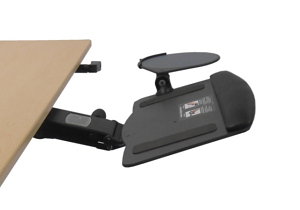How to Set up an Ergonomically Proper Desk Cycle

Call them desk pedals, desk cycles, under desk pedals, or desk ellipticals. Whatever you choose, all of these devices require a little upfront effort to get properly situated for comfortable, productive, and ergonomic use at a desk. This article brings you some expert tips based on our review staff’s experience testing various devices in the desk cycle category.
Don’t Hit Your Knees
By far, the most common complaint you’ll hear from new desk cycle users is banging their knees against the bottom of their desks. If there isn’t enough clearance under the desk, you can expect to develop some sore kneecaps. Obviously, this issue is going to plague taller individuals especially, and try as they may, no desk cycle manufacturer has been able to completely alleviate the problem. True, an elliptical pedal motion design helps by keeping the knees lower, but the problem persists. Fortunately, there’s a simple fix: Use an adjustable-height desk.
For most people, investing in an adjustable-height desk is a prerequisite for pedaling a desk cycle with sufficient knee clearance. By giving your legs room, you’ll be able to keep your chair close enough to the table to type and mouse freely. Besides, with a standing desk, you can also stand and keep out of your seat for a portion of the day. No one wants sitting disease, and let’s just be candid about the fact that sitting and pedaling is still sitting.
Follow these steps to identify the “sweet spot” position for your desk pedal:
- Put your pedal unit underneath your desk.
- Move your chair close enough to the desk to type and mouse comfortably.
- Adjust the height of your desk to give your knees clearance.
 Now, depending on your personal anthropometry, you may find that this places your keyboard too high to type comfortably for long periods of time. And there is a fix for that as well: Install an underdesk-mounted keyboard tray, such as the iMovR Stowaway Ergonomic Keyboard Tray. This will bring your keyboard closer to you and a few inches below the desk surface, with plenty of adjustment range to allow you to keep your shoulders back and your arms in a more neutral position.
Now, depending on your personal anthropometry, you may find that this places your keyboard too high to type comfortably for long periods of time. And there is a fix for that as well: Install an underdesk-mounted keyboard tray, such as the iMovR Stowaway Ergonomic Keyboard Tray. This will bring your keyboard closer to you and a few inches below the desk surface, with plenty of adjustment range to allow you to keep your shoulders back and your arms in a more neutral position.
Stabilize Yourself
If you pedal in an office chair that has caster wheels, the pressure from your pedaling will tend to roll your chair backwards, taking you farther and farther away from the pedal unit and your desk. Instead of lunging to grasp your keyboard, make sure your wheels are stabilized. You can accomplish this in a number of ways:
- Tether your chair to the pedal unit.
- Use wheel stoppers to keep your chair’s casters stationary.
- Replace your caster wheels with a locking variety.
- Ditch the wheels altogether and switch to a stationary chair.
Most units come either with a tether or wheel stoppers, but not all.
Some people may choose to leave their pedal unit in place all the time, but if you’re like most, you’ll want to move it out of the way when you’re not using it. If that’s the case, then we recommend marking the ideal placement of the pedal unit with masking tape once you’ve figured out the ideal chair position, desk height, and keyboard tray position. It’ll save you from having to figure it all out again every time you swap the pedal unit back in place.
Don’t Try to Be a Hero (at Least at First)
Cycling and working takes some getting used to. There’s a learning curve. Things will get better with practice, but keep in mind that cycling is not as natural a movement for our bodies as walking, for instance. We’ve been walking since we were toddlers. It’s ingrained in our biological history. Cycling, not so much. Many users will find it difficult or impossible to perform higher level cognitive functions while cycling because it takes a conscious effort to keep pedaling.
Task switching during the workday often leads to suspending the pedal movement. We know many users who pedal while reading but pause when typing, both for ergonomic reasons and for the sake of proper concentration on the task at hand. Our recommendation is to keep your cycling for more passive activities like reading emails or watching webinar videos. Studies have shown that it’s actually very difficult for the arms to remain independent while cycling (see this guest post from Dr. Michael Sliter of Indiana University-Purdue University Indianapolis for details). Typing on a laptop or desktop computer while cycling is a tall order. Though not necessarily better from an ergonomic standpoint, cycling while typing on a mobile device or tablet may be easier for some.
Hope these tips have helped you think through how best to optimize your workspace for a desk cycle. Feel free to contribute any other tips in the comments below.

7 Comments
Leave a response >